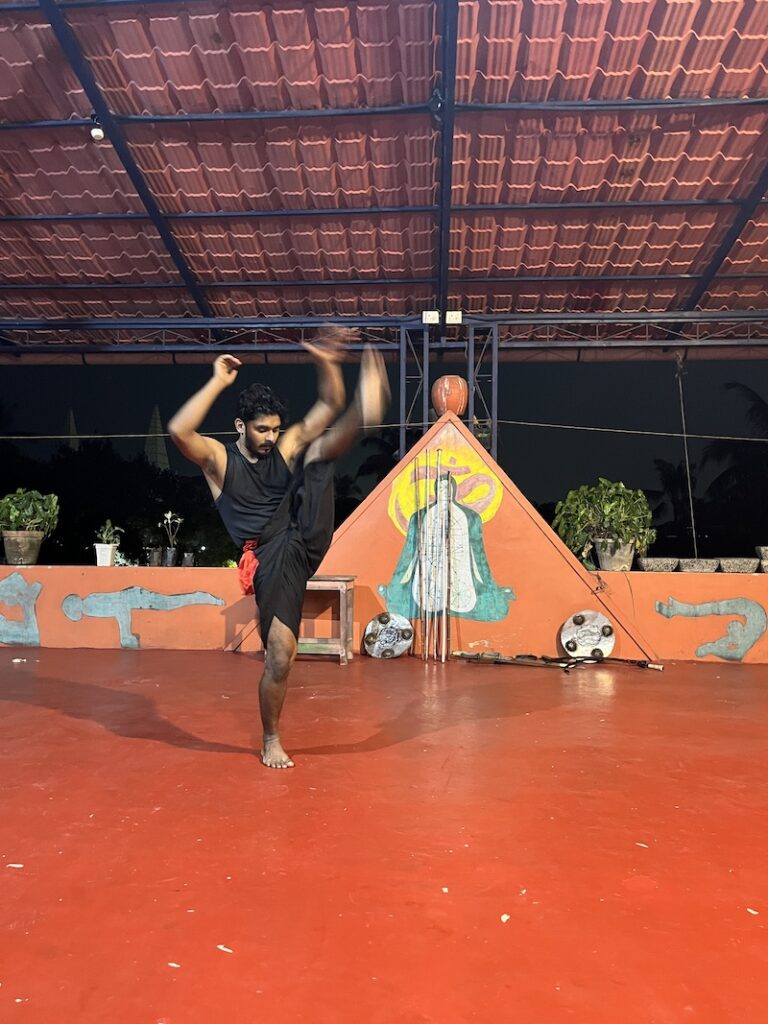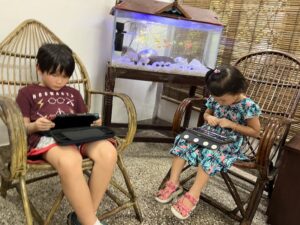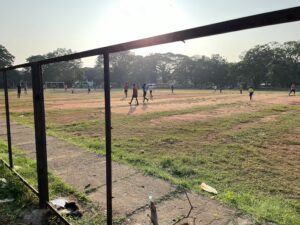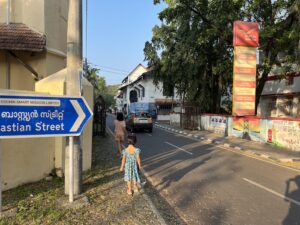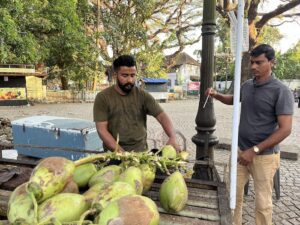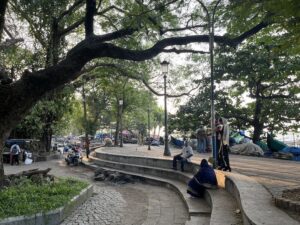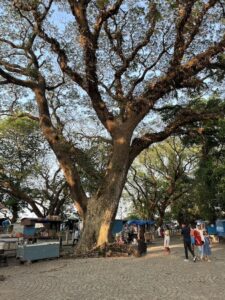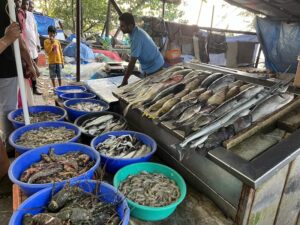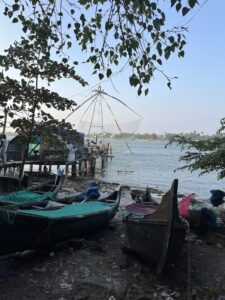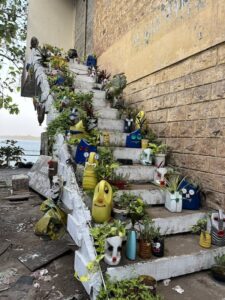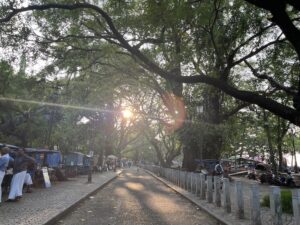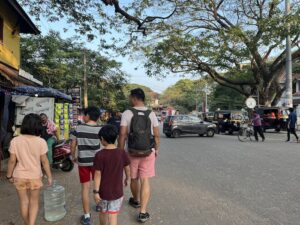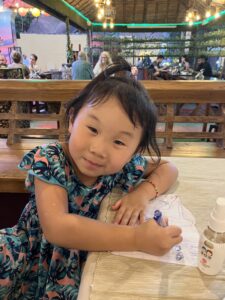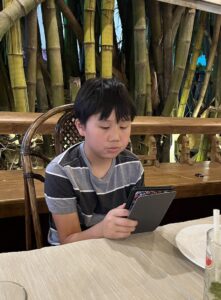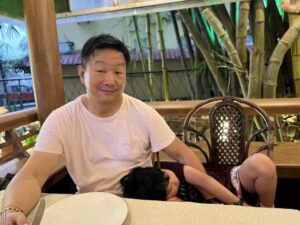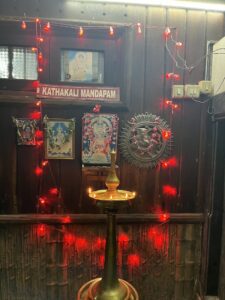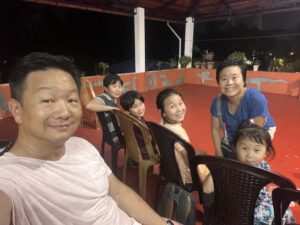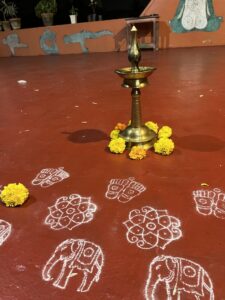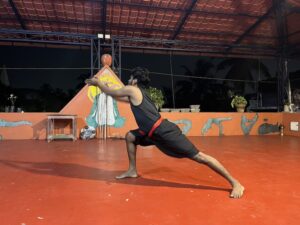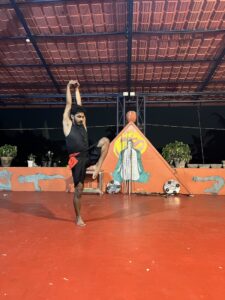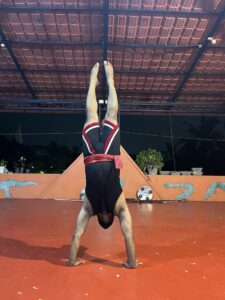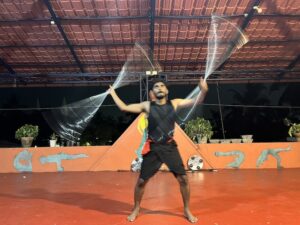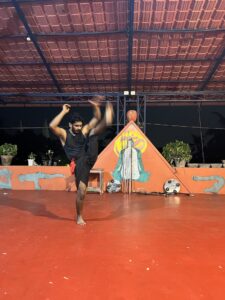We spent our first day in Kochi doing the things we would have done on any random weekend in Shanghai. We had a leisurely breakfast, the kids played, each of us did a bit of reading and caught up on some work and then, we headed out to our favorite shop. When we found out that there was a Decathlon in Kochi, we absolutely had to drop in. I am usually impatient when it comes to shopping. I don’t like browsing at things for too long unless I am searching for something in particular that I intend to buy. I remember really enjoying shopping when I was a teenager, but I have since realized that there are not many material things in the world that are special and the things that are, you can’t find them in a shop.
Decathlon is a little different. For families, they have made shopping for sporting goods not only affordable, but interactive. Instead of keeping everything secure in its packaging, Decathlon invites kids to try out the equipment. It is like a trip to the park or playground, but there is a lot of sports equipment to play with. When the kids were small, Decathlon was among our top choices for rainy-day activities. They could easily spend a morning jumping on the trampolines, climbing in and out of the tent displays, trying out the scooters and roller blades, kicking or throwing a ball around, shooting archery, even riding bikes and “working out” on the weights and gym equipment. Even now, it is easy to spend a few hours in Decathlon browsing and playing.
The next day, we ventured into Kochi. I had booked full-body Ayurvedic traditional massages for Leo and me at Ayurville, a serious center for Ayurvedic treatment. I have never had any experience with Ayurveda, but I thought it would be a good time to give it a try and learn a little about Ayurveda.
In the west, Ayurveda is considered an alternative medicine. Just like in China where TCM (Traditional Chinese Medicine) is viewed as another healthcare option, in India, Ayurveda is just considered a normal part of caring for one’s health. Ayurveda goes beyond just physical health. It is more of a philosophy and emphasizes mental wellbeing just as much as physical health. In order to be “healthy”, a person must have balance and harmony that is achieved with a good diet, regular sleep and exercise and low stress. Followers of Ayurveda often practice yoga, meditation and control their diet.
We arrived at Ayurville and entered a modest lobby with a few rattan chairs. Apart from day treatments, Ayurville also offers homestays for guest patients who want multi-day treatments and sessions with Ayurvedic doctors. We were only going to be there for a one-hour massage and we planned to have the kids wait for us in the lobby. They came prepared with their iPads and once they started playing and watching, they hardly noticed that there was no air-conditioning.
The massage therapist led me into a small bare room with a wooden massage bed. I was handed some cotton underwear and asked to lie down on the massage bed. I don’t know what I was expecting, but the massage was nothing special. It didn’t feel as good as the countless Chinese massages I had gotten in Shanghai. The only notable difference was the oil that they used which was hot and had the distinct smell of coconut oil. The massage seemed to emphasize rhythmic movements rather than pressure and penetration into my muscles and tissue, that I am used to in Chinese massage.
Leo and I emerged from our respective rooms to find the kids sitting in the exact position that we left them. They were still engrossed in their iPads and had no idea how much time had passed. When the kids asked me if I enjoyed the massage, I could only say that it was ok.
We proceeded on foot to Old Kochi, the historical area of Kochi. Although Old Kochi is often referred to as Fort Kochi, there is no fort so to speak of. In its original incarnation, Fort Kochi was the first European colonial fort built in India called Fort Emmanual. It was constructed by the Portuguese in 1503 and destroyed by the Dutch when they invaded in 1662. In the following years, the Dutch built their own fort in the same location which was then destroyed by the British. The remains of the fort are believed to be underground or underneath other existing structures in Old Kochi.
The fascinating history of Fort Kochi is told by the three colonial powers that ruled this once sleepy fishing village in succession and turned it into a major trading port that enriched the people and the European powers that fought to control it. Kochi is the only place in the world that was ruled successively by three European colonial powers. The Portuguese were the first to arrive in Kochi and founded the first European settlement in India. They created an unlikely alliance with the royal family of the Cochin kingdom who allowed them to construct a fort, Fort Emmanual. The Saint Bartholomew church, later rebuilt into the St. Francis church, was also constructed during this time.
The Portuguese ruled for about 160 years until the invasion of the Dutch. The Dutch were attracted to Cochin because of the massive profits the Portuguese enjoyed in their trade with Kerala. The Dutch intended to protect and monopolize the spice trade around the southern tip of India (Malabar Coast) and Sri Lanka (Ceylon). This required them to defeat the Portuguese and control the major ports in these areas.
In 1662, the Portuguese were defeated by the Dutch and Cochin came under Dutch rule. Fort Emmanuel and much of the city were destroyed by the Dutch who then rebuilt their own fort in the same location. Under Dutch rule, Cochin became a major center of the spice trade, and the city enjoyed its greatest prosperity. Cochin was already a well-established melting pot of cultures and religions that included Indians, Arabs, Chinese, Europeans and Jews that followed Hinduism, Islam, Christianity and Judaism.
In 1814, under the Anglo-Dutch Treaty, the Dutch and British made an exchange. The Dutch ceded Cochin to Britain in exchange for parts of present-day Indonesia. British rule over Kerela ended in 1947 when India gained its independence.
We passed by the Parade Ground, where the British and Dutch once conducted military drills and parades. It was filled with youths playing what looked to be field hockey. We knew we had entered Fort Kochi when the buildings started to take on the distinctive Dutch architecture with white-washed exteriors. We reached Vasco da Gama Square where we strolled around and enjoyed the local scene.
We stopped to watch fishermen operating the famous Chinese fishing nets that have become a symbol of the Kerala backwaters. The contraption is made out of bamboo and resembles a giant webbed claw with a complicated operation that requires four to five men. These fishing nets are believed to have been introduced to Kochi by Zheng He, China’s most famous sea explorer, sometime in the mid- to late-14th century. Another version of the story is that the nets were brought to Kochi by Portuguese traders. Who knows which version is accurate. Years ago, there were dozens of Chinese fishing nets lining the coast. Today, there are just a handful remaining because they are being replaced by more efficient modern fishing methods.
We had a quick dinner and headed to our evening entertainment at the Kathakali Center. The name of the center comes from Kerala’s unique style of traditional dance called Kathakali dance. This dance form emerged in Kerala over 300 years ago and is identified by the elaborate costumes, vibrant make-up and expressive hand gestures.
Although the Kathakali Center is most well-known for Kathakali, we weren’t there to watch dancing. Knowing that traditional dance wouldn’t be appreciated by the kids, I decided to book the martial arts show instead.
Kalaripayattu is an Indian martial art that grew out of hand-to-hand combat techniques from Kerala during the 11th-12th century. It is believed to be the oldest form of martial arts in the world and the original martial art that gave birth to other martial arts including Kung Fu.
The show featured three main fighters who truly dazzled us with their flexibility, strength and speed. They were of very different sizes and builds, but size and build didn’t seem to be the most important features in Kalaripayattu.
The show started with a display of forms and stretching before it moved into one-on-one combat. First, the two fighters fought bare-handed, without weapons. The show intensified with one fighter armed with a dagger while the other fighter was empty-handed. Then the other weapons came out. The fighters used long staffs, swords and a metal ribbon.
For the entire duration of the show, we were on the edge of their seats. We knew that the fighting, to a certain extent, was choreographed and the fighters trained together to make the fighting seem real. Even with choreography and practice, there is still a large margin of error because of the sheer speed and power of the actions. During the show, one of the fighters appeared to actually injure his arm. Apparently in pain, he stood on the side for a while holding his arm close to his body until another fighter stretched and forcefully bent his elbow, probably popping it back into its socket.
At the end of the show, the fighters invited audience members onstage to learn some fighting and self-defense moves. I urged RY to volunteer for a chance to learn first-hand. He and DY seem to love play-fighting, wrestling and dueling so much that I thought he would jump at the chance. He declined and said he just wanted to watch. When the fighters took out the swords and invited the audience to duel, I thought for sure DY would want to give it a try. He declined and said he just wanted to watch. So, we watched two American guys wearing Hawaiin shirts with coconut trees, stereotypical of the type of guys I went to business school with, get up and face each other. One of the Kalaripayattu fighters taught the smaller guy how to use his size to his advantage and maneuver to cause his opponent to lose his balance and eventually disarm him. RY and DY, sitting side by side, watched intently. Maybe they even learned a few things they can use to best each other in their next tussle.
Author
-

Song is the mother of four children. She and her family have stepped away from it all and in September 2023, began traveling the world while homeschooling. Song is an ABC (American born Chinese) and has an undergraduate degree from Cornell and an MBA from Harvard. She is an entrepreneur and an educator. Her hobbies include learning, traveling, reading, cooking and baking, and being with children.

